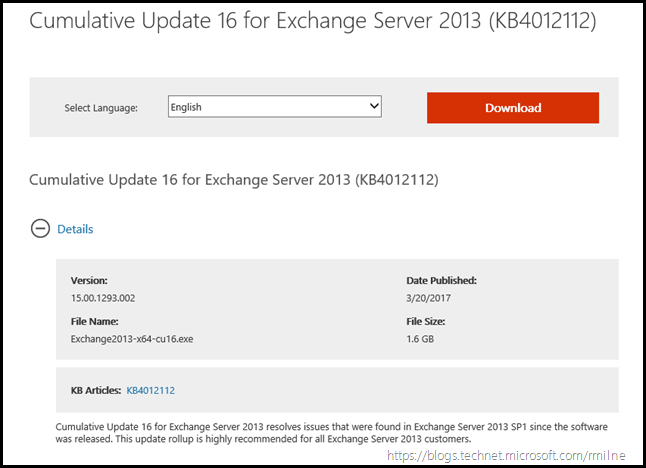Exchange 2013 CU16 has been released to the Microsoft download centre! Exchange 2013 has a different servicing strategy than Exchange 2007/2010 and utilises Cumulative Updates (CUs) rather than the Rollup Updates (RU/UR) which were used previously. CUs are a complete installation of Exchange 2013 and can be used to install a fresh server or to update a previously installed one. Exchange 2013 SP1 was in effect CU4, and CU16 is the twelfth post SP1 release. How time flies…..
This is build 15.00.1293.002 of Exchange 2013 and the update is helpfully named Exchange2013-x64-cu16.exe. Which is a great improvement over the initial CUs that all had the same file name! Details for the release are contained in KB 4012112.
Whether or not your AD Schema needs to be updated depends upon your initial Exchange 2013 version. This will dictate if the AD Schema needs to be modified. Check the values as noted in this post. There may be additional RBAC definitions, so PrepareAD should be executed prior to installing CU16. If setup detects that PrepareAD is required it will be automatically executed if the account running setup has the necessary permissions. This was an issue first discussed in the MessageCopyForSentAsEnabled post.
Note that CU6 will have changes and improvement to TLS, specifically TLS 1.2.
Updates Of Particular Note
CU16 contains the latest time zone updates.
As announced in the Exchange CU15 release post the .NET framework requirement has changed. Exchange 2013 CU16 requires .NET framework 4.6.2. Since .NET 4.62 framework support was first added in CU15, this adds an upgrade item. Ideally Exchange 2013 servers will already be on that CU15 build and .NET can be upgraded prior to installing CU16. If not, upgrade to CU15, do the .NET upgrade and then upgrade to CU16.
Issues Resolved
KB4013606 Search fails on Exchange Server 2016 or Exchange Server 2013
Some Items For Consideration
As with previous CUs, this one also follows the new servicing paradigm which was previously discussed on the blog. The CU package can be used to perform a new installation, or to upgrade an existing Exchange Server 2013 installation. You do not need to install Cumulative Update 4 or 5 for Exchange Server 2013 when you are installing the latest CU. Cumulative Updates are well, cumulative. What else can I say…
After you install this cumulative update package, you cannot uninstall the cumulative update package to revert to an earlier version of Exchange 2013. If you uninstall this cumulative update package, Exchange 2013 is removed from the server.
- Test the CU in a lab which is representative of your environment
- Review this post to also factor in AD preparation which is to be done ahead of installing the CU onto the first Exchange server
- Follow your organisation's change management process, and factor the approval time into your change request
- Provide appropriate notifications as per your process. This may be to IT teams, or to end users.
- Place the server into SCOM maintenance mode prior to installing, confirm the install then take the server out of maintenance mode
- Place the server into Exchange maintenance mode prior to installing, confirm the install then take the server out of maintenance mode
- I personally like to restart prior to installing CU. This helps identifies if an issue was due to the CU or happened in this prior restart, and also completes any pending file rename operations. 3rd party AV products are often guilty of this
- Restart the server after installing the CU
- Ensure that all the relevant services are running
- Ensure that event logs are clean, with no errors
- Ensure that you consult with all 3rd party vendors which exist as part of your messaging environment. This includes archive, backup, mobility and management services
- Ensure that you do not forget to install this update on management servers, jump servers/workstations and application servers where the management tools were installed for an application. FIM and 3rd party user provisioning solutions are examples of the latter
- Ensure that the Windows PowerShell Script Execution Policy is set to “Unrestricted” on the server being upgraded or installed. See KB981474
- Disable file system antivirus prior to installing. Do this through the appropriate console. Typically this will be a central admin console, not the local machine
- Verify file system antivirus is actually disabled
- Once server has been restarted, re-enable file system antivirus
- Note that customised configuration files are overwritten on installation. Make sure you have any changes fully documented!
- While CU16 does not add any new AD Schema changes. If you are on an out-dated CU currently, then deploying CU16 may contain AD Schema updates for your organisation – please test and plan accordingly! Whether or not your AD Schema needs to be updated depends upon your initial Exchange 2013 version. This will dictate if the AD Schema needs to be modified. Check the values as noted in this post. Additional RBAC definitions may also be required.
Please enjoy the update responsibly!
What do I mean by that? Well, you need to ensure that you are fully informed about the caveats with the CU and are aware of all of the changes that it will make within your environment. Additionally you will need to test the CU your lab which is representative of your production environment.
Cheers,
Rhoderick
